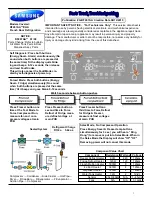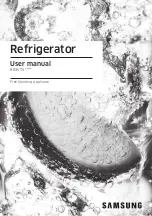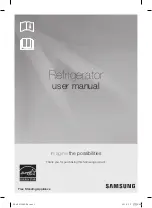
General Information
Water Supply Requirements
A cold water supply with water pressure of
between 35 and 120 psi (241 and 827 kPa) is
required to operate the water dispenser and
ice maker. If you have questions about your
water pressure, call a licensed, qualified
plumber.
Reverse Osmosis Water Supply
IMPORTANT:
The pressure of the water
supply coming out of a reverse osmosis
system going to the water inlet valve of the
refrigerator needs to be between 35 and
120 psi (241 and 827 kPa).
If a reverse osmosis water filtration system is
connected to your cold water supply, the
water pressure to the reverse osmosis
system needs to be a minimum of 40 to 60
psi (276 to 414 kPa).
If the water pressure to the reverse osmosis
system is less than 40 to 60 psi (276 to 414
kPa):
• Check to see whether the sediment filter in
the reverse osmosis system is blocked.
Replace the filter if necessary.
• Allow the storage tank on the reverse
osmosis system to refill afer heavy usage.
• If your refrigerator has a water filter, it may
further reduce the water pressure when
used in conjunction with a reverse osmosis
system. Remove the water filter.
If you have questions about your water
pressure, call a licensed, qualified plumber.
19
18
Moving Unit
• NEVER transport the refrigerator on its side. If
an upright position is not possible, lay the
refrigerator on its back. Allow refrigerator to
sit upright for approximately 30 minutes
before plugging it in to assure oil returns to
the compressor. Plugging the refrigerator in
immediately may cause damage to internal
parts.
• Use an appliance dolly when moving
refrigerator. ALWAYS truck refrigerator from
its side or back - NEVER from its front.
• Protect outside finish of refrigerator during
transport by wrapping cabinet in blankets
or inserting padding between the refrigerator
and dolly.
• Secure refrigerator to dolly firmly with straps
or bungee cords. Thread straps through
handles when possible. Do not overtighten.
Overtightening restraints may dent or
damage outside finish.
Electrical Requirements
Before you move your refrigerator to its final
location, it is important to make sure you
have the proper electrical connection.
Recommended Grounding Method
A 115 Volt, 60 Hz., AC only 15- or 20-amp
fused, grounded electrical supply is required.
It is recommended that a separate circuit
serving only your refrigerator be provided.
Use an outlet that cannot be turned of by a
switch. Do not use an extension cord.
NOTE:
Before performing any type of
installation, cleaning, or removing a light
bulb, turn the refrigerator OFF. Press the
freezer Down Arrow control until a dash (-)
appears in both the Freezer and Refrigerator
displays. Disconnect the refrigerator from the
electrical source. When you are finished,
reconnect the refrigerator to the electrical
source and reset the temperature controls to
the desired setting.
General Information
WARNING
Electrical Shock Hazard
Plug into a grounded 3 prong outlet.
Do not remove ground prong.
Do not use an adapter.
Do not use an extension cord.
Failure to follow these instructions can
result in death, fire, or electrical shock.
Summary of Contents for DDFB036
Page 22: ...43 42 Notes Notes ...








































